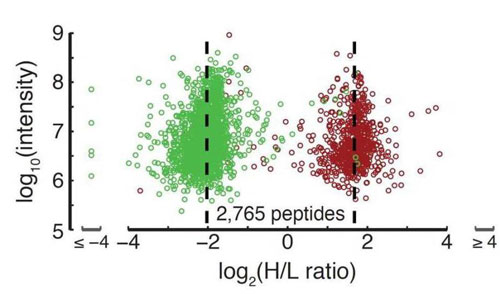| Jul 10, 2013 |
Researchers develop new method for tracking cell signaling
|
|
(Nanowerk News) Researchers at Memorial Sloan-Kettering Cancer Center, together with collaborators in Germany, have developed a new method for identifying the cell of origin of intracellular and secreted proteins within multicellular environments.
|
|
The technique, named cell type specific labeling using amino acid precursors (CTAP), exploits the inability of vertebrate cells to synthesize essential amino acids normally required for growth and homeostasis. The research was published online in the journal Nature Methods ("Cell-selective labeling using amino acid precursors for proteomic studies of multicellular environments").
|
 |
| Mass spectrometry analysis of peptides derived from a co-culture of CTAP-engineered human (red) and mouse cells (green) that become specifically labeled heavy and light, respectively. (Credit: Nicholas Gauthier, Chris Sander, Martin Miller)
|
|
This technological advance will provide investigators with a new tool for comprehensive mapping of cell-cell communication, which is important in all aspects of cancer development, maintenance, and response to therapy. For example, this method could be used to study cell signaling events between normal and malignant cells in order to better understand the molecular mechanisms by which surrounding normal cells alter tumor growth and response to treatment.
|
|
Gauthier, Miller and co-workers engineered cells to express amino acid biosynthesis enzymes, which enabled cells to grow on their own supply of amino acids produced from supplemented precursors.
|
|
The team went on to show that supplementing heavy stable isotope-labeled forms of these precursors led to incorporation of heavy amino acids into proteins produced in enzyme expressing cells. Using quantitative mass spectrometry to search for proteins that contained these stable isotope labels, researchers were able to determine the cell of origin of both intracellular and secreted proteins identified in multicellular culture.
|
|
By providing a means to link proteins directly to specific cell types, the authors believe that this new method will be useful in studies of cell-cell communication and biomarker discovery.
|

